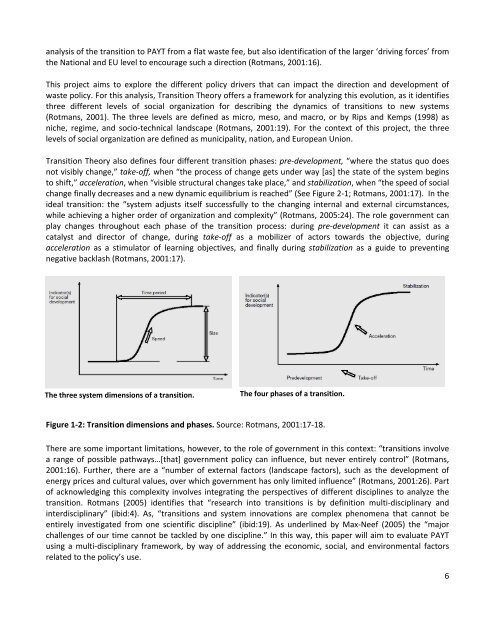Waste prevention and Pay as You Throw, a collective case ... - lumes
Waste prevention and Pay as You Throw, a collective case ... - lumes
Waste prevention and Pay as You Throw, a collective case ... - lumes
Create successful ePaper yourself
Turn your PDF publications into a flip-book with our unique Google optimized e-Paper software.
analysis of the transition to PAYT from a flat w<strong>as</strong>te fee, but also identification of the larger ‘driving forces’ from<br />
the National <strong>and</strong> EU level to encourage such a direction (Rotmans, 2001:16).<br />
This project aims to explore the different policy drivers that can impact the direction <strong>and</strong> development of<br />
w<strong>as</strong>te policy. For this analysis, Transition Theory offers a framework for analyzing this evolution, <strong>as</strong> it identifies<br />
three different levels of social organization for describing the dynamics of transitions to new systems<br />
(Rotmans, 2001). The three levels are defined <strong>as</strong> micro, meso, <strong>and</strong> macro, or by Rips <strong>and</strong> Kemps (1998) <strong>as</strong><br />
niche, regime, <strong>and</strong> socio‐technical l<strong>and</strong>scape (Rotmans, 2001:19). For the context of this project, the three<br />
levels of social organization are defined <strong>as</strong> municipality, nation, <strong>and</strong> European Union.<br />
Transition Theory also defines four different transition ph<strong>as</strong>es: pre‐development, “where the status quo does<br />
not visibly change,” take‐off, when “the process of change gets under way [<strong>as</strong>] the state of the system begins<br />
to shift,” acceleration, when “visible structural changes take place,” <strong>and</strong> stabilization, when “the speed of social<br />
change finally decre<strong>as</strong>es <strong>and</strong> a new dynamic equilibrium is reached” (See Figure 2‐1; Rotmans, 2001:17). In the<br />
ideal transition: the “system adjusts itself successfully to the changing internal <strong>and</strong> external circumstances,<br />
while achieving a higher order of organization <strong>and</strong> complexity” (Rotmans, 2005:24). The role government can<br />
play changes throughout each ph<strong>as</strong>e of the transition process: during pre‐development it can <strong>as</strong>sist <strong>as</strong> a<br />
catalyst <strong>and</strong> director of change, during take‐off <strong>as</strong> a mobilizer of actors towards the objective, during<br />
acceleration <strong>as</strong> a stimulator of learning objectives, <strong>and</strong> finally during stabilization <strong>as</strong> a guide to preventing<br />
negative backl<strong>as</strong>h (Rotmans, 2001:17).<br />
The three system dimensions of a transition.<br />
The four ph<strong>as</strong>es of a transition.<br />
Figure 1‐2: Transition dimensions <strong>and</strong> ph<strong>as</strong>es. Source: Rotmans, 2001:17‐18.<br />
There are some important limitations, however, to the role of government in this context: “transitions involve<br />
a range of possible pathways…[that] government policy can influence, but never entirely control” (Rotmans,<br />
2001:16). Further, there are a “number of external factors (l<strong>and</strong>scape factors), such <strong>as</strong> the development of<br />
energy prices <strong>and</strong> cultural values, over which government h<strong>as</strong> only limited influence” (Rotmans, 2001:26). Part<br />
of acknowledging this complexity involves integrating the perspectives of different disciplines to analyze the<br />
transition. Rotmans (2005) identifies that “research into transitions is by definition multi‐disciplinary <strong>and</strong><br />
interdisciplinary” (ibid:4). As, “transitions <strong>and</strong> system innovations are complex phenomena that cannot be<br />
entirely investigated from one scientific discipline” (ibid:19). As underlined by Max‐Neef (2005) the “major<br />
challenges of our time cannot be tackled by one discipline.” In this way, this paper will aim to evaluate PAYT<br />
using a multi‐disciplinary framework, by way of addressing the economic, social, <strong>and</strong> environmental factors<br />
related to the policy’s use.<br />
6
















